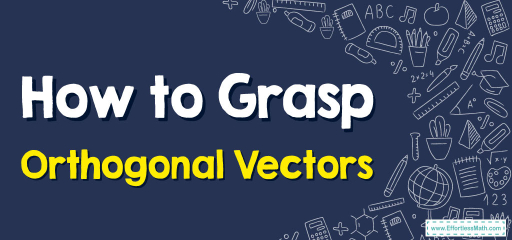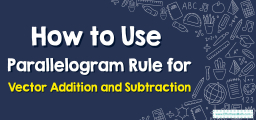How to Grasp Orthogonal Vectors
Orthogonal vectors are vectors that meet at a right angle, meaning they are perpendicular to each other. In the context of vectors, "orthogonal" is essentially a sophisticated way of saying "perpendicular".

Step-by-step Guide to Understand Orthogonal Vectors
Here is a step-by-step guide to understanding orthogonal vectors:
Step 1: Prelude – The Enchanted Realm of Vectors
Before we embark on our voyage into orthogonality, we must first delve into the world of vectors: magnificent entities with both magnitude and direction. Think of them as arrows pointing the way through a multidimensional space.
Step 2: Orthogonality Unveiled – The Heart of Perpendicularity
At its essence, orthogonality is the romance of perpendicularity transposed into the domain of vectors.
- The Geometric Overture:
- Two vectors are termed orthogonal if they meet at a pristine right angle in space. This encapsulates the notion of perpendicularity but with a touch of algebraic finesse.
- The Algebraic Dance:
- When vectors are orthogonal, their dot product is zero. This is the algebraic hallmark of orthogonality.
- Formally, for two vectors \( \overrightarrow{A}\) and \(\overrightarrow{B}\), if: \(\overrightarrow{A}⋅\overrightarrow{B}=0\), then the vectors are orthogonal.
Step 3: The Dot Product – The Key to Orthogonality’s Secret Garden
The dot product of two vectors sometimes termed the scalar product, is a scalar (number) that provides insight into the angle between vectors.
- Recapitulation of Dot Product:
- For vectors \(\overrightarrow{A}=A_xi+A_yj\) and \(\overrightarrow{B}=B_xi+B_yj\), \(\overrightarrow{A}⋅\overrightarrow{B}=A_xB_x+A_yB_y\).
- Unlocking Orthogonality:
- If \(\overrightarrow{A}⋅\overrightarrow{B}=0\), it unveils the vectors’ orthogonal nature.
Step 4: Traversing Orthogonal Dimensions:
- \(2D\) Orthogonal Ballet:
- In a \(2D\) space, orthogonal vectors seem to dance a duet, one on the \(x\)-axis and the other on the \(y\)-axis, meeting at a crisp \(90\)-degree angle.
- \(3D\) Orthogonal Symphony:
- In the vast expanse of \(3D\) space, vectors can be orthogonal in a myriad of configurations. One might soar along the \(z\)-axis while the other glides along the \(x\)-axis, yet they never truly ‘touch’ except in the perpendicular sense.
Step 5: Applications – Where Orthogonality Reigns Supreme
- Linear Algebra: Orthogonal vectors are the bedrock of orthogonal matrices, aiding in efficient computations and transformations.
- Signal Processing: Orthogonality prevents interference between signals, ensuring clarity and precision.
- Computer Graphics: They help in defining normals to surfaces, facilitating realistic rendering of light and shadow.
Step 6: Concluding Reflections – The Awe of Right Angles
In the vast universe of vectors, orthogonality stands as a beacon of structured order, a testament to the beauty of right angles in a world of direction and magnitude. Whether you’re an artist captivated by perpendicular lines or a mathematician mesmerized by algebraic properties, the concept of orthogonal vectors offers a harmonious blend of geometry and algebra. Embrace the elegance, and let the orthogonal vectors illuminate your mathematical pursuits!
Examples:
Example 1:
Given vectors: \(\overrightarrow{R}=(5,7)\), and \(\overrightarrow{S}=(7,−5)\), determine if the vectors are orthogonal
Solution:
To determine if the vectors are orthogonal:
Compute their dot product: \(\overrightarrow{R}⋅\overrightarrow{S}=5×7+7×(−5) =35−35 =0\)
Since their dot product is zero, vectors \(\overrightarrow{R}\) and \(\overrightarrow{S}\) are orthogonal.
Example 2:
Given vectors: \(\overrightarrow{T}=(1,−3)\), and \(\overrightarrow{U}=(3,1)\), determine if the vectors are orthogonal
Solution:
Again, compute their dot product: \(\overrightarrow{T}⋅\overrightarrow{U}=1×3+(−3)×1=3−3=0\)
Once again, since their dot product is zero, vectors \(\overrightarrow{T}\) and \(\overrightarrow{U}\) are orthogonal.
Related to This Article
More math articles
- How to Prepare for the ISEE Middle-Level Math Test?
- How to Find Limits at Infinity
- Slope Fields Simplified: Understanding the Core of Differential Equations
- The Fundamental Theorem of Algebra
- Properties of the Vertical Lines
- What Are the Applications of the Law of Sines?
- The Ultimate 7th Grade SOL Math Course (+FREE Worksheets)
- How to Solve Systems of Equations with Substitution?
- 6th Grade PEAKS Math Worksheets: FREE & Printable
- Top 10 8th Grade PARCC Math Practice Questions
























What people say about "How to Grasp Orthogonal Vectors - Effortless Math: We Help Students Learn to LOVE Mathematics"?
No one replied yet.